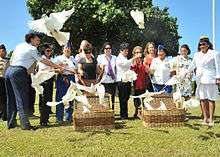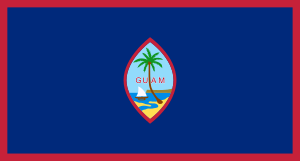Ricardo Bordallo
| The Honorable Ricardo Bordallo | |
|---|---|
| 2nd and 4th Governor of Guam | |
|
In office January 3, 1983 – January 5, 1987 | |
| Lieutenant | Edward Diego Reyes |
| Preceded by | Paul McDonald Calvo |
| Succeeded by | Joseph Franklin Ada |
|
In office January 6, 1975 – January 1, 1979 | |
| Lieutenant | Rudy Sablan |
| Preceded by | Carlos Camacho |
| Succeeded by | Paul McDonald Calvo |
| Senator in the Guam Legislature | |
|
In office January 7, 1957 – January 4, 1971 | |
| Chairman of the Democratic Party of Guam | |
|
In office 1961–1963 | |
| Preceded by | Position Established |
| Succeeded by | Adrian L. Cristobal |
|
In office 1971–1973 | |
| Preceded by | Joaquin A. Perez |
| Succeeded by | Francisco Carbullido |
| Personal details | |
| Born |
Ricardo Jerome Bordallo December 11, 1927 Hagåtña, Guam |
| Died |
January 31, 1990 (aged 62) Chief Quipuha Park, Agana, Guam |
| Resting place | Pigo Cemetery, Anigua |
| Nationality | Guamanian |
| Political party | Democratic Party of Guam |
| Spouse(s) | Madeleine Mary Zeien (m. 1953; wid. 1990) |
| Children | Deborah Bordallo |
| Alma mater | University of San Francisco |
| Profession | Businessman, Politician |
Ricardo Jerome "Ricky" Bordallo /bərˈdæljoʊ/ (December 11, 1927 – January 31, 1990) was a Guamanian politician, businessman, and member of the Democratic Party of Guam. He served as Governor of Guam from 1975 to 1979 and again from 1983 to 1987.
Early life
Ricardo Jerome Bordallo was born in Hagåtña, Guam. He was the son of Baltazar Jeronimo Bordallo (August 8, 1900 – May 1984) as a businessman, who died when his father was 83, and his mother Josefina Torres Pangelinan. He was the first child of a family including his brother Paul Joseph Bordallo (1930–2007), who was a former senator. BJ Bordallo was a popular politician from the 1930s to 1950s. Ricardo Bordallo attended the University of San Francisco before returning to Guam and becoming a successful businessman and car dealer. Among other positions, he was the proprietor of "Ricky's Suburban Club," a restaurant and bar in Tamuning, Guam. Bordallo also established "Ricky's Auto Company" in the mid 50's which became Toyota's first American car dealer.
Personal life
He was married to Madeleine Zeien Bordallo in 1953; together they have one daughter Deborah, and one grandchild, Nicole Nelson. Bordallo's widow was an unsuccessful candidate for governor in 1990, and served as Lieutenant Governor of Guam from 1995 to 2003, and as the island's Delegate to the United States House of Representatives since 2003.
Political career
Senator of the Guam Legislature
Bordallo was first elected to the Guam Legislature in 1956 as a member of the Popular Party (predecessor to the Democratic Party of Guam). Bordallo served in the territorial legislature from 1956 to 1970, and twice served as Chairman of the Democratic Party of Guam. As a senator, he introduced the law that first created an unofficial Guam delegate to the U.S. Congress.
Bordallo-Taitano Gubernatorial Ticket (1970)
Bordallo first ran for governor in the 1970 election, which was the first election in which the people of Guam were allowed to elect their governor. He ran with Senator Richard "Dick" Taitano against two other former gubernatorial teams: Former governor Manuel Guerrero and running mate Dr. Antonio C. (Tony) Yamashita, as well as attorney and former speaker Joaquin Camacho Arriola and running mate Vicente Bamba, retired judge and popular former senator. Bordallo-Taitano came in first in the primary election by a close margin over Guerrero-Yamashita, and then won the run-off election. However, due to the contentious Democratic campaign, Bordallo-Taitano lost in the general election to the Republican team of incumbents Carlos G. Camacho and Kurt S. Moylan. The election was significant for Bordallo, however, as he and Dick Taitano created Guam's first "grassroots" political organization throughout the villages.
Governorship (1975–1979)
Bordallo-Sablan Gubernatorial Ticket (1974)
Bordallo's wife, Madeleine, also proved to be a passionate and untiring campaigner and helped draw many supporters to the organization. This organization and base of supporters would prove valuable when Bordallo ran again in the 1974 election. Madeleine Bordallo was most known for her humanitarian pursuits. She sponsored many civil cultural events including the Guam Symphony and a program for instructing children in the Suzuki method of violin.
Bordallo ran for governor for a second time in 1974, this time with Rudolph "Rudy" Guerrero Sablan. They were up against four other Democratic tickets: Manuel Guerrero and running mate David D.L. Flores; Pedro C. Sanchez and Esteban U. Torres; and Joaquin Arriola and Theodore "Ted" Nelson. Dick Taitano was the manager of the Bordallo-Sablan campaign and broadened the organization he had set up in 1970. This organization proved decisive, and Bordallo-Sablan easily beat the other Democratic teams.
Bordallo-Sablan then went on to beat the Camacho-Moylan team, which had just barely beat the Republican rival team of Paul Calvo and Antonio Palomo in the primary. Calvo ran as a write-in candidate in the general election, drawing support from Camacho-Moylan, and Bordallo-Sablan won by less than 600 of the 22,000-plus votes.
First term 1975–79
Bordallo's first term in office, from 1975–1979, was contentious. He was characterized as highly charismatic but highly controversial. Someone wasn't afraid to speak his mind on any issue. During this time the issue of independence, statehood, commonwealth status or continuation as a U.S. territory was put to the voters. Senator Paul Bordallo, his brother, favored independence. The voters elected to keep the status quo as a dependent territory. Bordallo was successful in securing $367 million for typhoon reconstruction, capital improvement project and Government of Guam investments. A new was secured at the Guam Memorial Hospital.
Bordallo-Sanchez Gubernatorial Ticket (1978)
In 1978, Bordallo ran for re-election with a former University of Guam president Dr. Pedro C. Sanchez as his running mate for lieutenant governor. Lieutenant Governor Sablan declared his candidacy for the gubernatorial election and was a candidate in the September 1978 Democratic primary, along with his running mate for Lt. Governor was Attorney Jose Iglesias Leon Guerrero. Bordallo won the Democratic primary and defeated the Sablan-Leon Guerrero campaign with more votes. However, Bordallo lost to the Republican Calvo-Ada team in the gubernatorial general election.
Governorship (1983–1987)
Bordallo-Reyes Gubernatorial Ticket (1982)
Bordallo ran for a third time political arena in 1982 with a political unknown, Air Force Colonel Eddie Reyes, as his running mate. He beat out Democrats Carl Gutierrez and John P. Aguon for the Democratic nomination and won office yet again. Promising to guide Guam out of the recession and push for commonwealth status, the Bordallo/Reyes ticket defeated incumbent Governor Calvo in the 1982 elections.
Second term 1983–87
Bordallo's second term in office, from 1983–1987. During his second term, Bordallo chaired the Commission for Self-Determination and spearheaded the drafting of the Guam Commonwealth Act developed by June 4, 1986. He addressed Guam's education problems with his 1983 "Blueprint for Excellence" and worked on the accreditation status of the University of Guam. He went to Washington D.C. on January 20, 1985 with congressman Ben Blaz at the Officers Club, and Andrews Air Force Base.
Bordallo-Reyes Gubernatorial Ticket (1986)
Bordallo sought re-election with Lt. Gov Edward D. Reyes as his running mate. The ticket won the Democratic nomination when they defeated by Senator Gutierrez and Senator John P. Aguon in the primary election. Bordallo lost the general election to former Lieutenant Governor Ada and Senator Frank F. Blas in the general election.
Post-governorship
Criminal conviction
In February 1987, Bordallo was convicted on ten counts of corruption and was sentenced to nine years in prison and fined more than $100,000. He was accused of receiving over $100,000 worth of bribes and extortion in connection with favors he performed in office for campaign contributions. His convictions on eight counts of bribery and extortion were overturned in August, 1988, leaving charges of obstruction of justice and witness tampering. On December 13, 1989, he was sentenced to four years in prison on the remaining charges.[1]
Suicide
After his failed appeal to the U.S. Supreme Court, Bordallo faced a four-year sentence in a federal minimum-security prison beginning on February 1, 1990. Three hours before he was scheduled to be transferred to a prison in Boron, California on January 31, 1990, the former Governor committed suicide in Hagåtña by wrapping himself in a Guam flag, chaining himself to statue of Chief Kepuha (also Quipuha, Guam's first native chief to convert to Roman Catholicism) located along Marine Corps Drive (the island's primary thoroughfare), and shooting himself in the head with a .38 caliber pistol. He had also set up four placards around the monument, one of which said: "I regret that I only have one life to give to my island," an altered quote by Nathan Hale.
Bordallo died of massive brain damage at 4:28 P.M. at Naval Hospital, aged 62. He was buried at Pigo Cemetery in western Hagåtña.
Honors

In January, 1997, the administration facility was officially named as Ricardo J. Bordallo Governor's Complex in his honor.
References
External links
- Ricardo Bordallo Bio at Guampedia, Guam's Online Encyclopedia
| Political offices | ||
|---|---|---|
| Preceded by Carlos Camacho |
Governor of Guam (1st Term) 1975–1979 |
Succeeded by Paul McDonald Calvo |
| Preceded by Paul McDonald Calvo |
Governor of Guam (2nd Term) 1983–1987 |
Succeeded by Joseph F. Ada |
| Party political offices | ||
| Preceded by None |
Democratic Party of Guam chairman 1961–1963 |
Succeeded by Adrian L. Crisotbal |
| Preceded by Joaquin A. Perez |
Democratic Party of Guam chairman 1971–1973 |
Succeeded by Francisco Carbullido |
| Preceded by None |
Democrat gubernatorial election 1970 (lost) 1974 (won) 1978 (lost) 1982 (won) 1986 (lost) |
Succeeded by Madeleine Bordallo |
